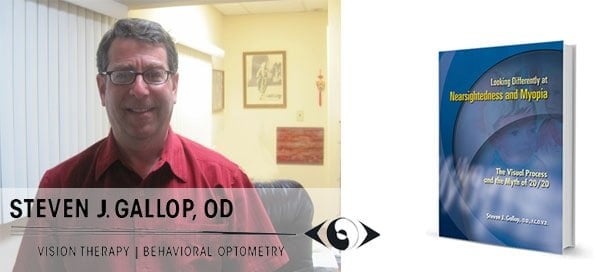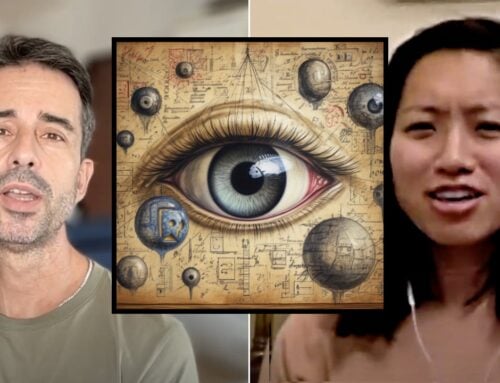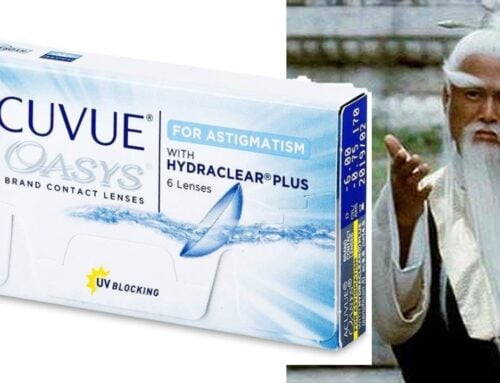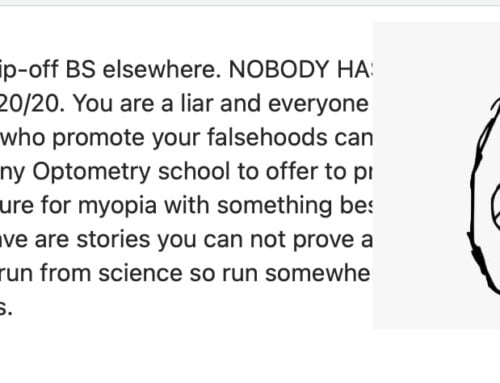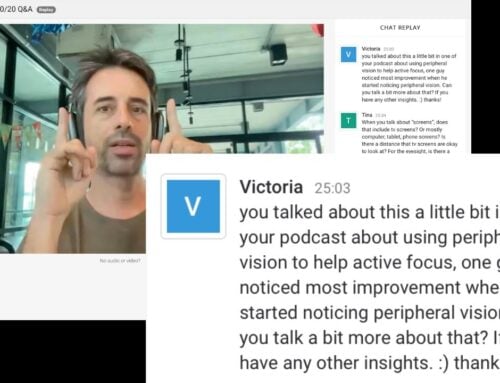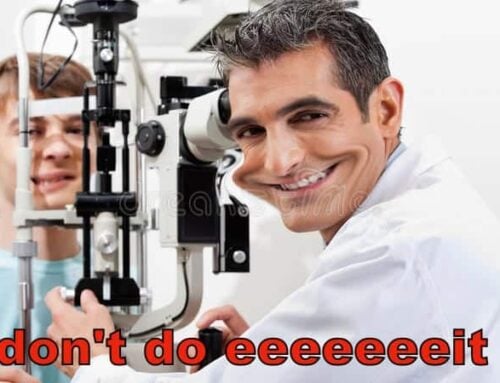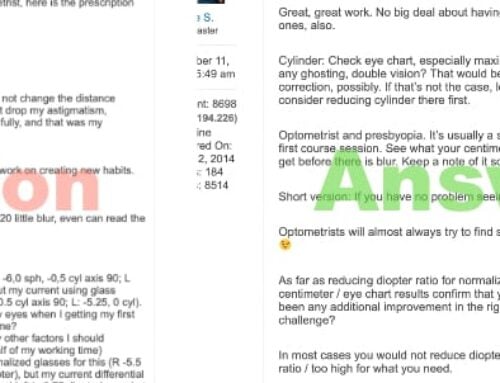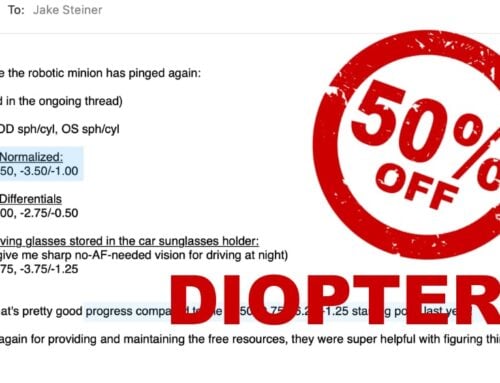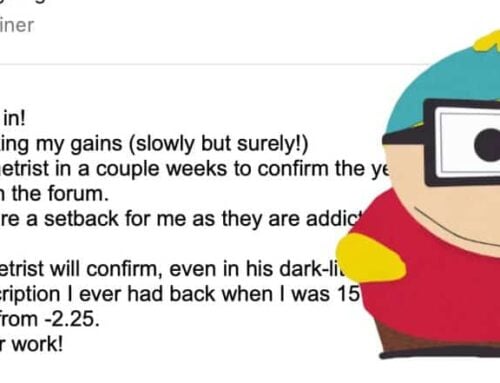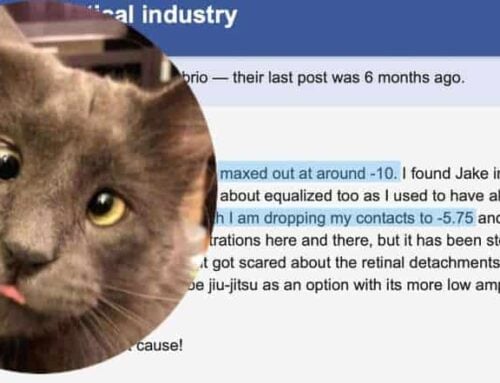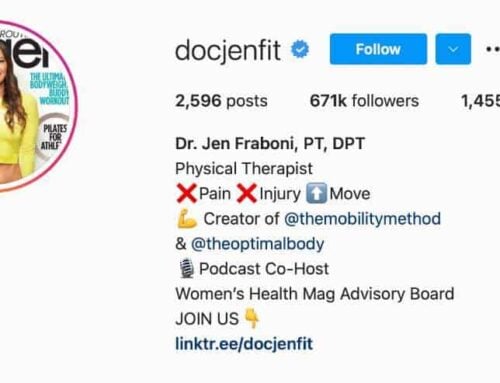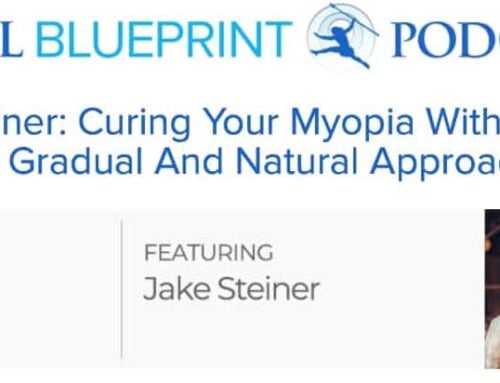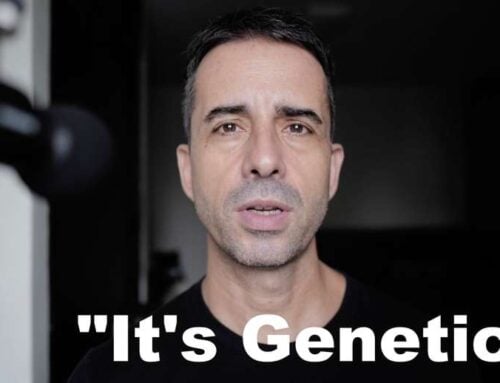As promised yesterday, today we have Dr. Steve Gallop as our guest.
Dr. Gallop is a behavioral optometrist in private practice in Pennsylvania, in the USA. Published on numerous occasions in the Journal Of Behavioral Optometry and author of the book “Looking Differently at Nearsightedness and Myopia”, Dr. Gallop looks at causality rather than mere symptom treatment.
Let’s get straight to the interview!
Jake: You mention in your video that you went to optometry school in your 30’s, and at that time discovered eyesight problems. In wanting to get into causes and not just symptom treatment, how do you feel the school’s education supported your desire for understanding? Was there emphasis on causality vs. symptom management?
Dr. Gallop: My eyesight problems were detected early in my life, but the more important issues went completely unnoticed until much later. I always like to differentiate between eyesight and what I refer to as the visual process. Eyesight refers to how clearly we see, while the visual process is a brain/body process that consists of a much more complex integration of many things including peripheral awareness, eye movements, eye teaming and focusing, among other things.
I was first diagnosed as being nearsighted at age 8, but it wasn’t until I was in my 30s that I was diagnosed with other visual issues – eye teaming and focusing problems. Knowing what I know now, I would bet that these problems predated the onset of nearsightedness. Tracking, eye teaming and focusing are the fundamental issues in the visual process, seeing clearly emerges from these foundational skills in most cases.
Unfortunately, most doctors believe that seeing clearly (and the physical health of the eyes) is the only important issue. They have decided this without much if any interest in the complexity of the visual process and visual development. I put much less emphasis on eyesight and much more on the other aspects of the visual process. For the most part, colleges of optometry follow the thinking and practices of ophthalmology – medically trained eye care professionals – who think eyesight is all there is for the most part.
I had to go outside of the basic academic program to really learn the things I wanted to find out about the visual process, and how to manage causes rather than just the symptoms. I was fortunate to be able to spend time with doctors who had been practicing with a behavioral philosophy for many years when I met them. I have had and continue to have great mentors.
Jake: In your professional circle, how would you assess the perception of your type of practice, vs. the more common type of quick exam followed by lens prescription type of practice? Is there curiosity on part of other optometrists, are things changing, what would be your take on the state of the optometry profession as you see it?
Dr. Gallop: Well, my immediate professional circle has been purposefully shaped and sized to maximize my continued growth and development as a vision care provider and to minimize my frustration with the standard of care as provided by most doctors. I will say that I have seen a flood of articles in professional publications about all kinds of new ways to prevent and control nearsightedness. Unfortunately, to my way of thinking, these techniques are all still focused on the symptom – nearsightedness.
The other thing I take issue with is that all of these approaches are aimed at doing something to the eyeball. The eyeball itself actually has a fairly small part to play in the visual process as compared to what happens in the rest of the brain. So, while there is finally some recognition of the importance of better managing nearsightedness, the thinking behind much of what is coming out remains rooted in the past and in the eyeball. For example, the common wisdom still says that nearsightedness is caused by the stretching (lengthening) of the eyeball. I think it is more likely that inefficient use of the visual system, which can be improved with vision therapy and proper lenses, could very well lead to a stretching of the eyeball. So the change in the eyeball is the result of how the system works, a result and not the cause of the problem. Nearsightedness is not the problem; it is a sign of how a person has attempted to solve more complex visual deficiencies.
Another thing that bothers me is that most of the popular books and websites out there are also stuck in the eyeball – and nobody wants to get stuck in the eyeball. That is one reason I decided to write my first book, Looking Differently at Nearsightedness and Myopia: The Visual Process and the Myth of 20/20. I had read many of the books, and checked out many of the do-it-yourself programs available and found them very lacking. I wanted to get something out there that provided a more complete and more honest perspective on what all the issues and possibilities were.
Jake: Some optometrists tell us that they can’t afford to get very detailed. We get a lot of stories about “a quick fix is what our customer wants”, as well as competitive pressure and the need to sell at volume to cover overhead and expenses. How do you think your more in depth approach affects your practice? Do you hear those stories, and if so, what are your thoughts? What can the average optometrist do to add value to the consult, look into causes and help the patient, while still dealing with economic realities?
Dr. Gallop: They can afford to do whatever they want. If their priority is money then that is what they will pursue. If they want to provide the best care possible then there are ways to do that. I’m afraid that what they are saying is that they don’t want to put the effort into finding a way to do something different. I’m sorry to be so blunt, but it is not all that difficult to help people prevent, control or reverse nearsightedness.
The funny thing is, I probably sell more glasses per patient than most other eye doctors. That is because of two main factors, neither of which has anything to do with money, but everything to do with providing the highest level of care that I know.
The first factor is I don’t think anyone should only have one prescription unless they only do one thing all day every day. Any nearsighted person should have a different prescription for near than what they use to see in the distance. It’s like wearing a heavy coat – you want to wear a heavy coat in the winter, but you will probably make yourself unwell if you wear this coat all year, especially in the summer. Lenses are a tool and sometimes you need a specific tool for a specific task. Reading through a distance prescription is one of the best ways to make yourself more nearsighted. Most doctors know this somewhere in the back of their minds, but choose to ignore it. So nearsighted children should either have bifocals or a separate reading prescription; the same holds for any nearsighted person. New research is beginning to acknowledge this fact, though I’m not hopeful that this research will make it into mainstream knowledge, and I’m fairly certain that most doctors will continue to ignore it either way. Behavioral optometry has used this knowledge since the 1920s.
The second factor is behavioral optometry has understood for almost 100 years that the human visual system was not designed for the kind of close work that is prevalent in modern culture. The printed page is a fairly new arrival on the calendar of human history. Once behavioral optometrists understood this issue we learned that low-power convex lenses (usually much weaker than most doctors would prescribe), worn for close work, could play an important role in preventing or minimizing visual stress – the kind that causes a great deal of nearsightedness.
I worked part time in a high-volume practice when I was just starting out. Most of the people I examined had eye teaming, focusing and/or eye movement issues, but just wanted the quick fix. My philosophy of prescribing enabled me to provide a better quick fix than most other doctors would provide, but it made me sick to have to ignore the important visual issues I knew would remain an obstacle for these people. I didn’t last long in that environment. I admit that I gave up a much more comfortable lifestyle that comes from seeing huge numbers of patients, in favor of providing a higher quality of care to fewer people. It would not take much, nor would it reduce the profit margin of any optometrist to spend a few extra minutes or seconds to do a more comprehensive job of prescribing lenses.
Jake: A lot of optometrists we talk to have a very straightforward range of services, most of which is dealing with myopia and astigmatism. How does that relate to your practice? When you deal with myopia and astigmatism, what is your approach?
Dr. Gallop: I have a referral-only practice. Before the internet, this meant that another actual human had to tell someone about me. The internet has certainly broadened my definition of what a referral is. In any event, I don’t get to do much in the way of preventive care, so many of my adult patients are already wearing what are commonly referred to as “corrective lenses.” These lenses are of course not corrective in any way, and are very likely to contribute to a worsening of the very symptoms – nearsightedness and/or astigmatism – they are supposed to treat. I have helped countless people reduce their nearsightedness and I have helped just as many to eliminate the need (if it was ever really there) for lenses that mask astigmatism. I have written and lectured extensively about approaching nearsightedness and astigmatism differently. There is a good deal of information available on my website: GallopIntoVision.com and of course there is my book, which I mentioned earlier.
Jake: You have a great site. Does it help your business, in terms of attracting patients? Based on your experiences both with the Web and your approach, what would you recommend to new optometrists, as far as where to focus their approach and practice?
Dr. Gallop: Thanks. I am very proud of my website. I wrote, and continue to write, every word on it. I try to keep the blog active as much as possible. My site appears to have pretty heavy traffic, but I can’t say it has brought me as many actual patients as I hoped. My main goal with the website though is to put information out there.
I would recommend that new optometrists be more creative in their thinking and prescribing. As you are well aware, nearsightedness is best described as an epidemic. And I think more and more people are and will be looking for more creative approaches to preventing and managing nearsightedness as time goes by.
I would suggest new optometrists get on board with prescribing lenses we describe as developmental, stress-relieving, reading or near lenses for as many people as possible, starting at a very early age. Believe me when I tell you it was a bitter pill to swallow when I learned that the best way to avoid needing glasses was different glasses. Wearing the proper near lenses (you cannot buy these at any store, they must be prescribed) at the appropriate times can prevent the need of wearing glasses all the time since a good deal of nearsightedness results from the stress of close work on the visual system.
Jake: And then there is #endmyopia. It sounds impossible, stopping this worldwide epidemic of nearsightedness. You no doubt know the numbers. Myopia is still on the rise, and especially in Asia the numbers are barely conceivable. 80%, 90% of school children are diagnosed with myopia. Things going the way they are, do you think we will ever be able to create enough awareness to fight this tide?
Dr. Gallop: I don’t know about fighting this tide, but we must do what we can to help one person at a time and the internet is probably the best way to do this. I have tried to get other doctors to see the financial sense in providing better care, but even that didn’t seem to interest them because it involves being more thoughtful and creative and apparently that is distasteful. They only way things will really change is to inform the public to the real issues and possibilities. Doctors will only change when the public forces them to, by not showing up for standard eye exams and seeking out doctors with creative practices. Your website is certainly a great way to push a better message.
Now, with all the hand-held devices, from smart phones to tablets to digital readers, the likelihood is that nearsightedness numbers will rise even faster unless people learn that there is preventive care available.
Jake: Lastly, tell us a bit about your myopia book. What motivated you to write it? What would you say is the most controversial aspect of it, what would fellow optometrists take issue with there?
Dr. Gallop: One reason I became an optometrist because of my severe and increasing nearsightedness. Something inside me told me there had to be options other than what I had gone through. I began reading some of the books that came out of the Bates philosophy and then Bates himself. I think Bates had some good ideas, but those who followed him remained stuck in what I call eyeball thinking for the most part. I’m sure your readers are familiar with some of the books and do-it-yourself programs out there. I checked out most of what was available up through the early 1990s. I felt that most of them were doing a disservice to the public by providing an overly simplistic message.
Another reason I became an optometrist was to be able to understand the relationship between standard care and the Bates approach. Once I began to learn about all the issues involved, I became less and less enthusiastic about what I saw in the popular press. I came to realize that people would be best served by finding a knowledgeable behavioral optometrist who could help them really get what they needed in the best way possible. As it turns out, not even all behavioral optometrists are equipped to do the kind of work I do, but there are plenty of us out there and any behavioral optometrist is likely to be better than a regular optometrist or ophthalmologist when it comes to thinking differently about nearsightedness.
Anyone familiar with Bates is likely familiar with Aldous Huxley’s 1942 book, The Art of Seeing. Huxley tells about his positive experience with the Bates Method. This was in 1939. By the late 1960s Huxley found a behavioral optometrist, Dr. Donald Getz, with whom he did vision therapy. Huxley ultimately realized that vision therapy was a much more in-depth, more productive approach to vision enhancement.
As I mentioned earlier, I wanted to write a book from the perspective of someone who spent time in world of the patient, the Bates aficionado, the vision therapy patient and finally the behavioral optometrist. I was the first person I experimented on with reducing nearsightedness and my best success came from using lenses in a more strategic fashion along with vision therapy. I gained much more from this than simply reducing the strength of my glasses. I had less eye fatigue and I became a better reader and a better driver. I wanted people to know about behavioral optometry and vision therapy as a potent strategy for improving all aspects of the visual process.
I guess the most controversial aspect of my book is right there in the title: Looking Differently at Nearsightedness and Myopia: The Visual Process and the Myth of 20/20. I’m pretty sure that would rub just about any doctor not interested in thinking differently the wrong way. Luckily, I don’t suppose too many of them would ever bother picking the book up in the first place. Most optometrists believe there is one single prescription for a given patient to see 20/20. They simply do not want to imagine that there is anything else worth being concerned about.
I could probably go on and on, but you’d have to build a whole other website, so I’ll leave it there for now. I hope this adds to the dialogue your excellent website is making happen.
—
There it is!
You can grab a copy of Steve’s book here. If you are in the Pennsylvania area, you can book an 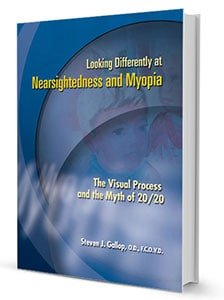 appointment via his Website. You can use our Q&A system to ask questions of Dr. Gallop, and I’ll see if we can get some more of his time to get those answered for you as well.
appointment via his Website. You can use our Q&A system to ask questions of Dr. Gallop, and I’ll see if we can get some more of his time to get those answered for you as well.
I plan to do introduce a new practitioner to you at least every other month (and hopefully more frequently). The goal is to cover as many geographical areas as possible to give more of you options to see a local practitioner. This will also add more perspectives, since there are a number of ways to look at eyesight health, symptoms and causes.
Do consider leaving comments, questions, or FB likes if you would like to have more interviews like this. It may very well affect the interest level of some practitioners, to see dialog and appreciation for their time here.
Questions for Dr. Gallop? Head over to the Q&A and click the “ask question” button.
Cheers!
– Jake Steiner

